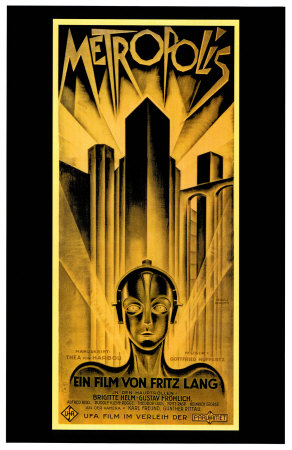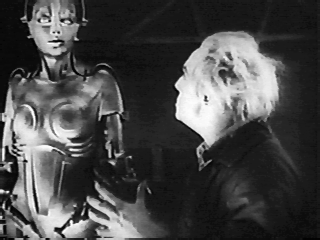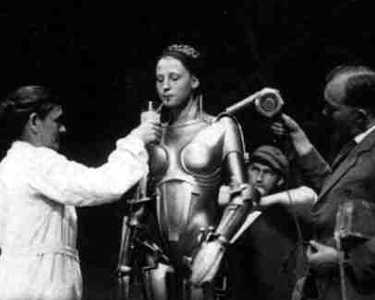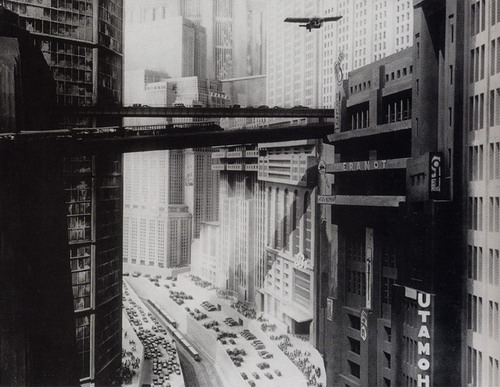Powet Alphabet: M is for Metropolis
by Crazy, filed in Movies, Powet Alphabet on Sep.25, 2010

Metropolis. Most readers have probably heard of this movie at one point or another. I would bet few have ever actually seen it, though.
It has many achievements to its name; one of the highest number of extras of any movie, the most expensive silent film ever made, but most importantly for the science fiction genre, the first movie to ever feature a female android, or gynoid. This is one of the many reasons that M is for Metropolis.
Read on to learn more about the movie and why we care about it.
Metropolis was written by Fritz Lang and his then-wife Thea von Harbou in 1924. It was initially published as a book in 1926 and would go on to be released as a movie directed by Lang in 1927.
The story takes place in futuristic and thriving city populated by the upper classes. Below the city, the working class toiled away to keep the city’s machines thriving. The leader of the city is Joh Fredersen. His son, Freder, happens upon a passage that leads to the depths of the city where the workers spend their days operating the machinery. There, he witnesses a great explosion at one of the machines, partially hallucinating in all of the steamy aftermath in a wonderful transformation of imagery. After witnessing this, he returns to his father immediately to report what he had seen, ignorant of the true machinations of how the Metropolis functioned.  Joh Frederson would go to Rotwang, the mad scientist/inventor for assistance, where Rotwang introduced Frederson to his latest creation, the Maschinenmensch, a machine-man, that he intended to make in the image of his former love (who had left him for Frederson). After this strange revelation, they traveled to the lower depths and spied on a gathering of workers.
Joh Frederson would go to Rotwang, the mad scientist/inventor for assistance, where Rotwang introduced Frederson to his latest creation, the Maschinenmensch, a machine-man, that he intended to make in the image of his former love (who had left him for Frederson). After this strange revelation, they traveled to the lower depths and spied on a gathering of workers.
Eventually, Freder would take the place of an underground worker to see what it was like to work in the city beneath the city, eventually finding himself in the presence of a great audience listening to a female teacher who told them of the city of Babel. A brilliant idea created by an architect with great meaning, but eventually the workers who were building the structure grew restless with their work without understanding its true meaning. The architect and the workers could not understand each other, though. The hands could not understand what the mind intended. The teacher, Maria, told of a prophecized link that would bring understanding to the two sides.
After hearing this story, Joh Frederson, who had been spying on the gathering with Rotwang, ordered the inventor to make the Maschinenmensch into the image of this woman. Once complete, the doppleganger would discredit this woman and bring order to the growing discontent of the workers. Once the gathering disperses, the woman sees Freder and pulls him aside. They speak and she essentially tells him that he is that link between the hands and the mind that will bring understanding. After Freder leaves, though, Rotwang carries out Joh Frederson’s plans by kidnapping Maria.
That is the basic plot of the story. I say basic because it does get further complicated, but as far as plot goes, this is the content that is needed to understand the direction of the story. I will not give away any endings or further plot points because they are not needed and there is far more to this movie than just the plot.
The movie originally played in Germany with a running length of about 155 minutes. After the initial screenings, the movie was drastically cut down before being sent out to the international audience. Much of the cut material had been thought lost, but over time various discoveries of reels with additional footage have been found. A mostly complete script of the movie was also pieced together from censor records from its original release. In 2001, a project was undertaken to restore the film to as much of its original form as possible in honor of its 75th anniversary. It received several awards upon completion. Missing scenes were filled in with tiles of text describing what was taking place. In 2008, an original cut was discovered in a Museum in Buenos Aires. This version would be merged in to fill some of the missing scenes from the restored copy of 2001.

I recently had the opportunity to see this now most complete version yet at a local movie theater. When one considers silent films in the present day, they automatically assume that because sound could not be accompanied with the video, that many other things were not possible in that time. As I sat and watched this film, I stood completely surprised at the special effects achieved in such an early movie. Not only in the beautiful renderings of the Metropolis itself, but also in the transformation of the Maschinenmensch into Maria.
Another aspect of this movie that truly impressed me for its time was the choreography. Two scenes in particular used amazingly well choreographed movements to display a general mood and tempo of the setting. The first was when the workers were changing shifts in the beginning of the movie and later again when Freder first happened upon the machine just before it exploded.
A great theme this movie has in common with other great movies in science fiction is that it is more than just about the technology. The technology is more of a macguffin, simply used to further the plot and its message or social commentary. Without giving away the ending of this movie, it is obvious from what I have revealed that this movie has ties to what could be considered social commentary.
william friedkin – conversation with fritz lang [ vostfr – 1974 ] from monolith on Vimeo.
An interesting interview with Fritz Lang

The influence of this movie is far-reaching, even today. From Futura’s design cues present in C3P0 of Star Wars, to the architectural style (referred to as Raygun Gothic) that can be considered a basis for future sci-fi classics like Blade Runner, Tron, Robocop and the Fifth Element. The movie poster even influenced the creator of Astro Boy to create an anime movie called Metropolis dealing with similar themes, despite him never having seen the original movie.
The newest remastered edition is still touring through the country with new screenings being announced regularly.
Official site of restored film
http://www.kino.com/metropolis/
Or you can watch the full movie on YouTube with a new score completely redone and modernized. I have to say, I rewatched it with this soundtrack and it drew me in even further.
However you are able to access this movie, watch it. There is a reason it is still talked about to this day.
And that is why M is for Metropolis.


 PS3
PS3
 Famicom Dojo
Famicom Dojo KEEP PLAYING
KEEP PLAYING KEEP PLAYING: Rewind
KEEP PLAYING: Rewind Powet Toys
Powet Toys Powetcast
Powetcast Hitchhiker's Guide POWETcast
Hitchhiker's Guide POWETcast














